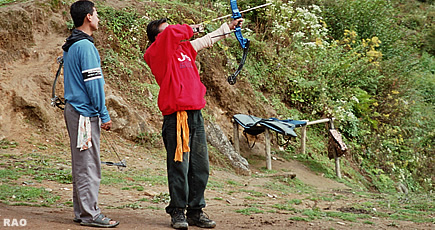 |
Bhutan's Sports Archery |
|
 |
Bhutan's Sports Archery |
|
|
 |
|
Tsips
- indispensable to the game and inseparable from the archers |
 |
Archery tournament
|
These
faces, so revered or reviled, are those of Tsips - something like
mediums who play the main part, more than the highest Karey hitter or even
the Dhobjey one. It is them, after all, who made it all possible.
They
are believed to have access to powers beyond mortal imagination. As for
delivery, archers have mixed feelings about their prowess. Modern times
and broad minds are also gradually, but determinedly, chipping away their
credibility.
|
|
The
Tsips, says an archer of many years from Changzamthog, who is known for
nothing more than archery, have been around for as long as the game of
archery has been.
They
were, in fact, there even before archery was a game. In the old days, they
guided arrows, not towards colourful targets, but at invading forces or
duelling factions.
The
stakes were much higher then, only if they proved a hoax, there was seldom
complaints. The gullible were long dead. Today, the role of Tsips have
mostly been confined to archery games and although the developments augur
no historical alterations, they are still potent. They can still command
people to go crazy. It is not uncommon to hear of a group of men, from
all walks of life, and normally of sound mind, grovelling about in a forest
all night. Such sights are, of course, rarely seen, as secret is the essence
of the stratagem. All the powers-that-be that have been evoked could as
easily be sent packing. For if such an excursion is spied by members of
the opposing team, a counter-offensive could be launched - one commanded
by another Tsip.
Tsips,
says the archer, are indispensable to the game and inseparable from the
archers. Mostly dervishes or people with some religious indoctrination,
they straddle the thin line between the power of persuasion and blind faith
today. It's the economics in modern times: either prove your worth or be
declared a fake, and lose face - and business. Nevertheless, the Tsip still
survives, albeit underground now.
For
the asking, they dictate every part of game. Beginning from the direction
of the range in the morning, to the choice of target. Forwards, backwards
or sideways: their word is law. They even decide when the order of players
should be changed and at what point in the game. They
perform countless rituals, be it a short one or one that takes an entire
day, and calls for the paraphernalia of a house Puja.
 |
| They
also become more indispensable because of the counter-offensive. A Tsip
can choose a target for his team while at the time cast spells on the other.
If one team has been told to camp out, the other Tsip can order a combing
operation with a piece from his ritual garb which, thrown at the spot of
the other camp, could undo all their hard work. It's about defilement.
And the tools can be both astounding and appalling. |
|
They are normally soil
from grounds of the dead, clothes stained with menstruation or any other
unclean object.
Kept atop vehicles of the other team, or rubbed on to their
equipment, such tactics, say archers, prove very effective.
More
dangerous still are the rituals done to undermine the capability of ace
archers from the opposing team. Tsips are believed to be able to make archers
fall sick or loose all sense of direction. Normally, the names and ages
of the other players are taken by the Tsip on a piece of paper. This bit
of paper is either stuck to a sewing machine or mixed, with unclean objects
before being buried at a crossroad or under the mattress of a pregnant
women.
Archers
say that the services of Tsips were always well rewarded. In the old days
a Tsip charged 400 Dheys (measure) of rice for his handiwork. A few years
before the new rules, a Tsip charged anywhere between Nu 10,000 to Nu 15,000.
Whileno
archer will admit such practice today, they, however do not drop their
guard when it comes to watching the antics of their opponents.
| This
article was contributed by KUENSEL, Bhutan's National Newspaper |
 |
 |
| More
Information |
 |
|



